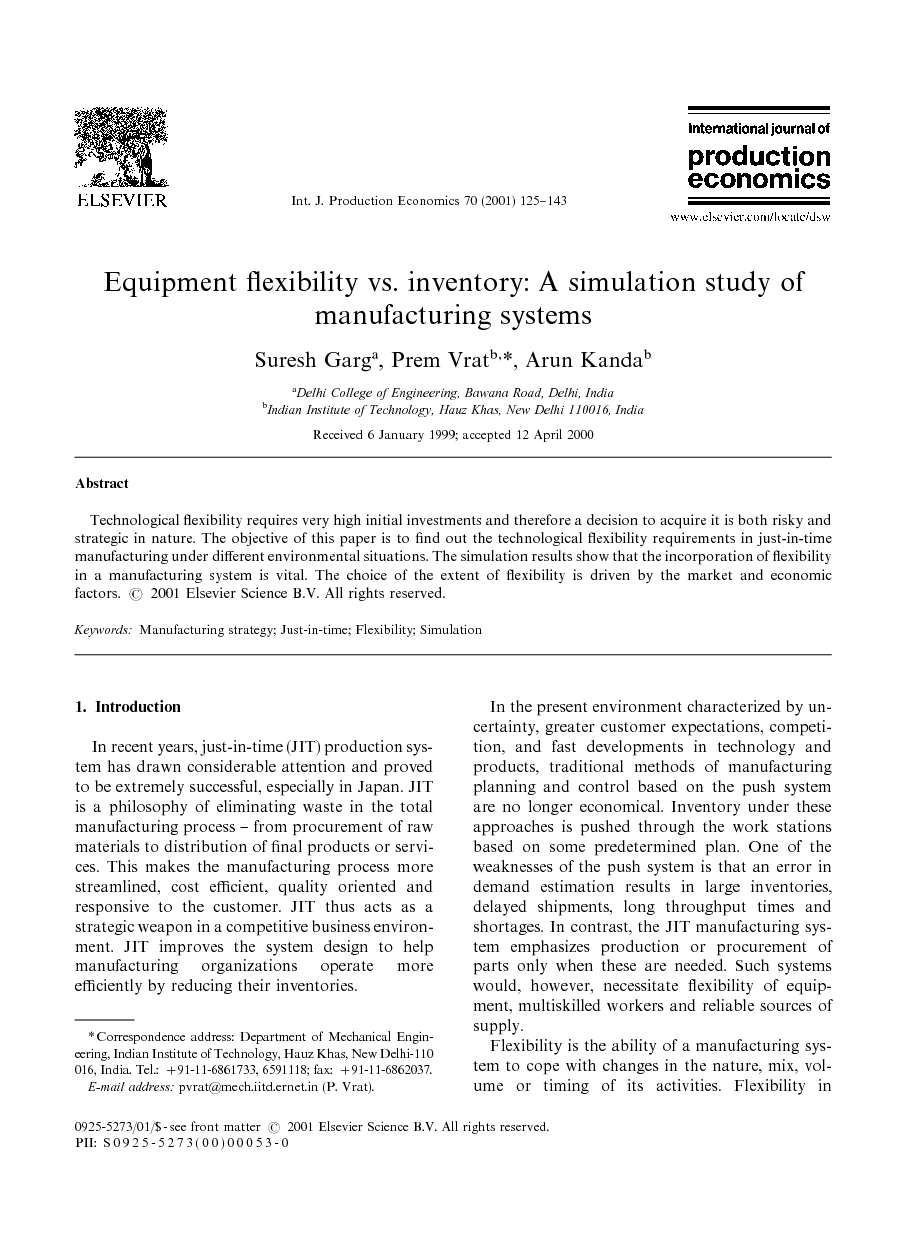Technological flexibility requires very high initial investments and therefore a decision to acquire it is both risky and strategic in nature. The objective of this paper is to find out the technological flexibility requirements in just-in-time manufacturing under different environmental situations. The simulation results show that the incorporation of flexibility in a manufacturing system is vital. The choice of the extent of flexibility is driven by the market and economic factors.
In recent years, just-in-time (JIT) production system has drawn considerable attention and proved to be extremely successful, especially in Japan. JIT is a philosophy of eliminating waste in the total manufacturing process – from procurement of raw materials to distribution of final products or services. This makes the manufacturing process more streamlined, cost efficient, quality oriented and responsive to the customer. JIT thus acts as a strategic weapon in a competitive business environment. JIT improves the system design to help manufacturing organizations operate more efficiently by reducing their inventories.
In the present environment characterized by uncertainty, greater customer expectations, competition, and fast developments in technology and products, traditional methods of manufacturing planning and control based on the push system are no longer economical. Inventory under these approaches is pushed through the work stations based on some predetermined plan. One of the weaknesses of the push system is that an error in demand estimation results in large inventories, delayed shipments, long throughput times and shortages. In contrast, the JIT manufacturing system emphasizes production or procurement of parts only when these are needed. Such systems would, however, necessitate flexibility of equipment, multiskilled workers and reliable sources of supply.
Flexibility is the ability of a manufacturing system to cope with changes in the nature, mix, volume or timing of its activities. Flexibility in a manufacturing system ensures that the production rate can be matched with demand, leading to savings in inventory-related costs, reduced lead times and increased quality.
Flexibility is not free, it comes at a cost. Flexibility more often means extra capacity either in the form of extra machines, technology or in manpower. For developing economies, where the cost of capital is high, the decision to acquire a flexible manufacturing system may not be economically justified, whereas for Japan and other capital rich countries it may be the ideal thing to do. The nature of industry also influences the relative importance of inventory control. For a highly capital intensive factory, machine utilization may be more important than inventory reduction. In a steel wire manufacturing company, a year of inventory may be insignificant as compared to one investment decision on the acquisition of a capital asset. On the other hand, in an automobile assembly, the raw materials are high value added items and the inventories are indeed a major cost component.
Thus JIT is not feasible in developing countries and traditional just-in case (JIC) has its own demerits. JIC tends to cover up problems existing in the factory. JIC systems are push systems in which control policy gives a production trigger based on forecasted demand and predicted product flow in the production and inventory system. Under these policies inventory is considered as an asset. It protects against forecast error, machine problems and late vendor deliveries.
Non-feasibility of JIT and demerits of JIC lead to an interesting research poser, namely, to determine the best mix of JIT and JIC for these conditions. Certain external and internal factors decide the design of the mix of JIT and JIC for formation of a ‘JIT like’ manufacturing system which is economical to operate and meets competition.
The intent in this paper is to investigate the effects of technological flexibility to find out the extent of flexibility required in an environment characterized by different levels of variability. By creating the choice set and evaluating the alternatives on economic criteria, the study suggests how to actually achieve such flexibility. This results in the development of ‘JIT-like’ manufacturing system to meet the challenges of competition.
This paper has presented the results of a simulation study to investigate the requirements of technological flexibility for the implementation of JIT manufacturing system. It is found that the performance measure of JIT systems is very much affected by the incorporation of the flexibility in the system under probabilistic demand conditions. Therefore, incorporation of flexibility is vital. The choice of the extent of flexibility is driven by the market volatility, market expectations, economic and industrial development and other internal and external factors.
Desired customer service from a manufacturing system can be achieved through flexible equipment or through inventories. The choice is based on economics. JIT systems with high flexibility and low safety stock are very sensitive to manufacturing delays. On the other hand, flexibility is more suitable for multiple product manufacturing system with correlated demand. This simulation study reveals that there can be no unique answer to the flexibility: inventory mix and alternative strategies have to be evaluated to determine the best option for a given situation.


